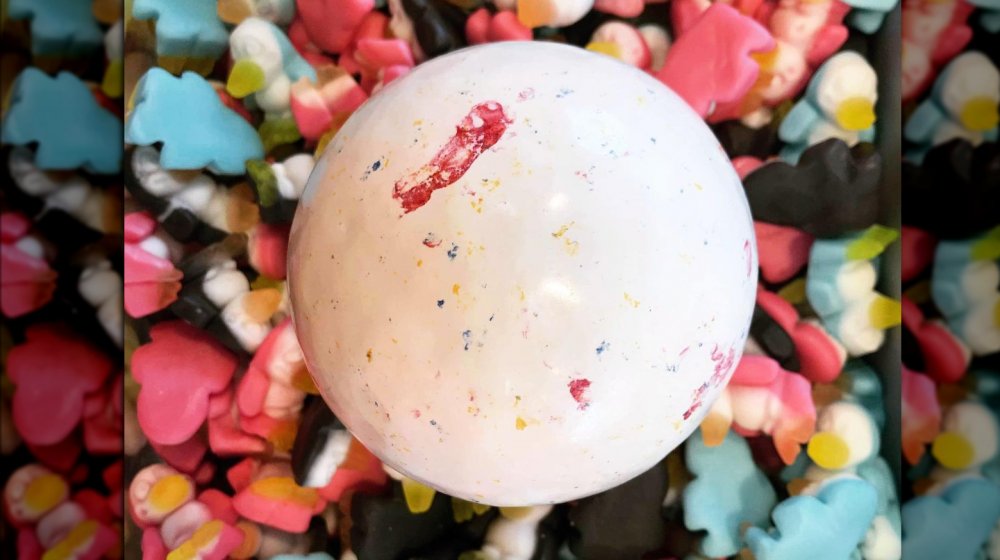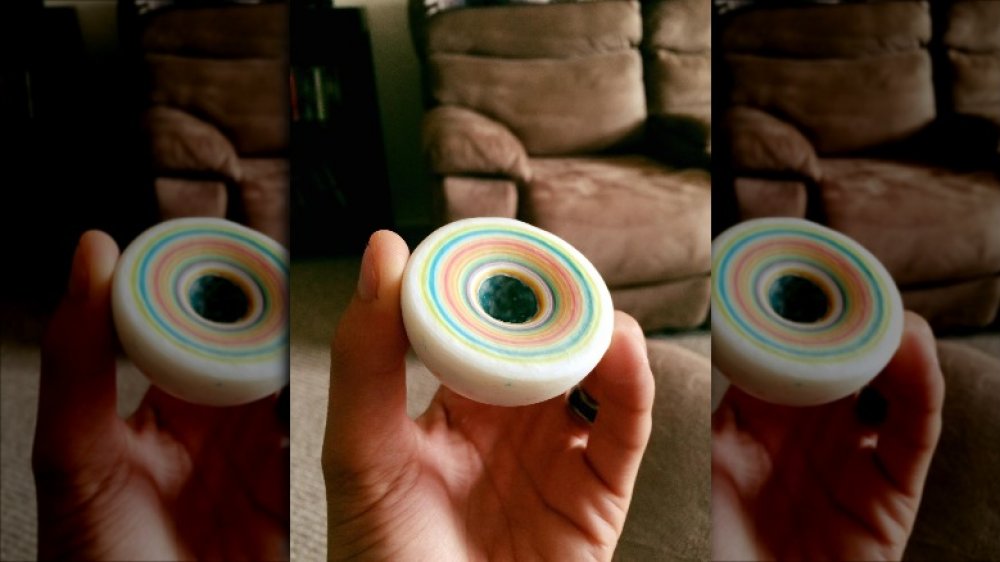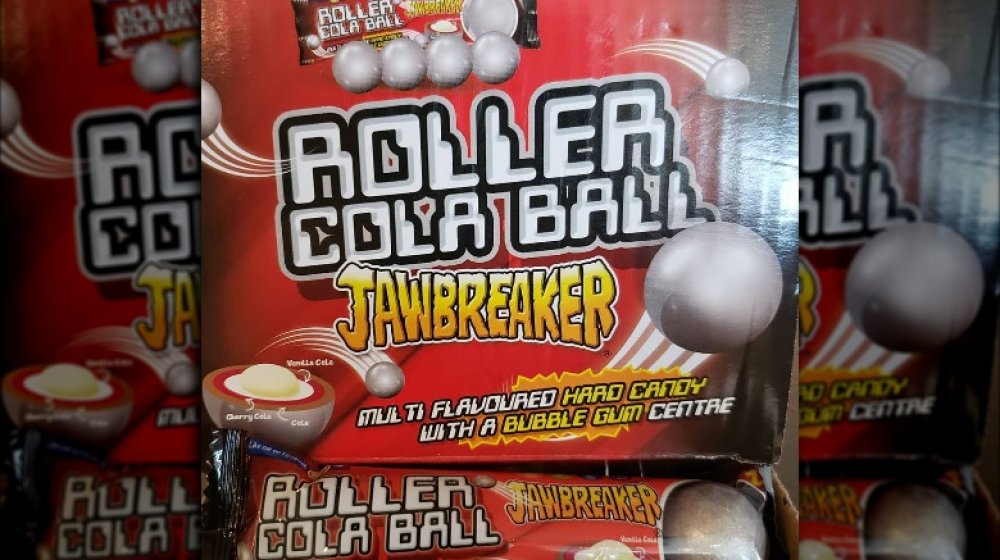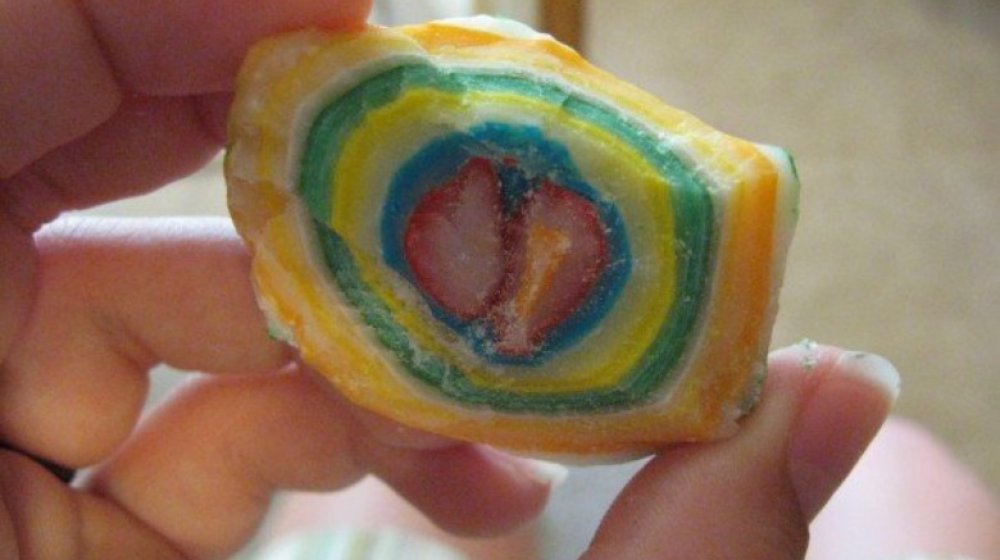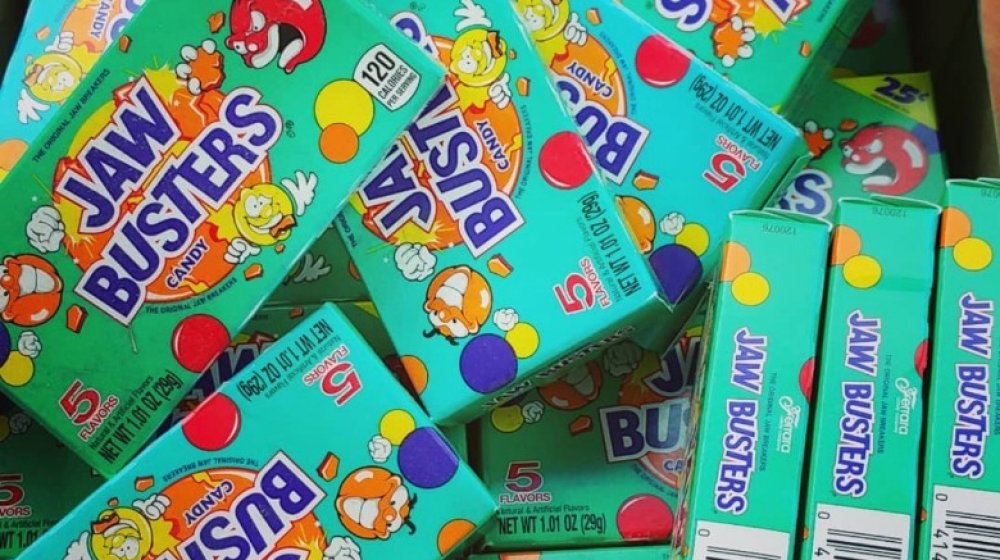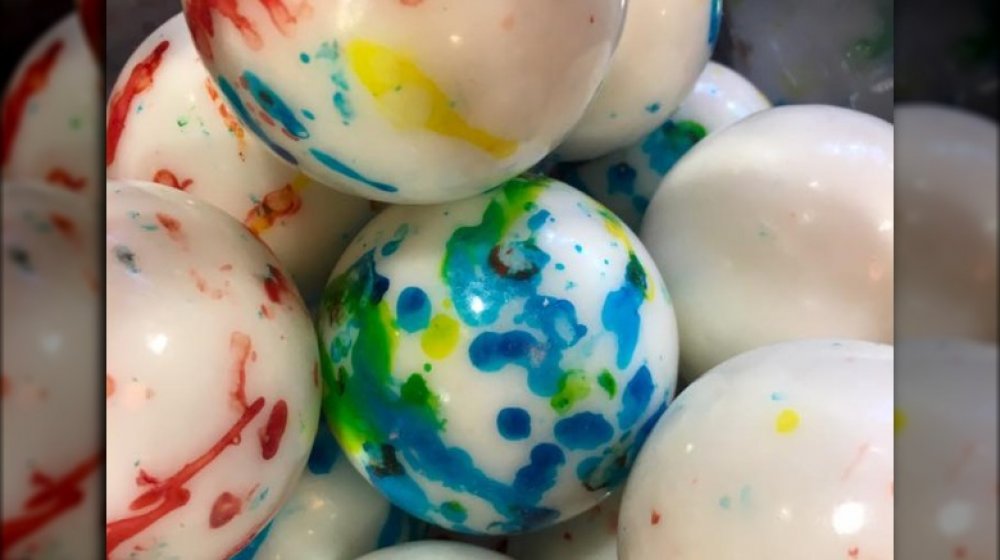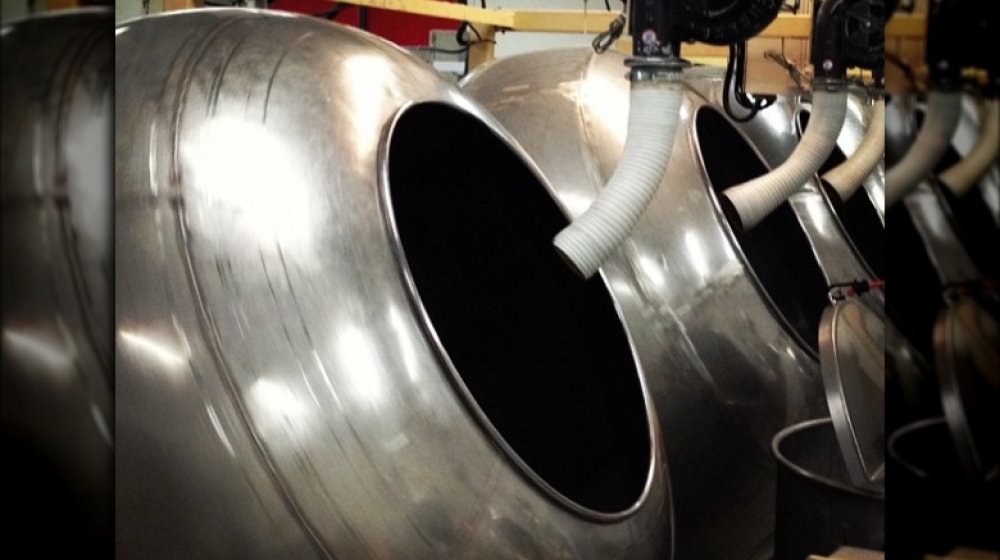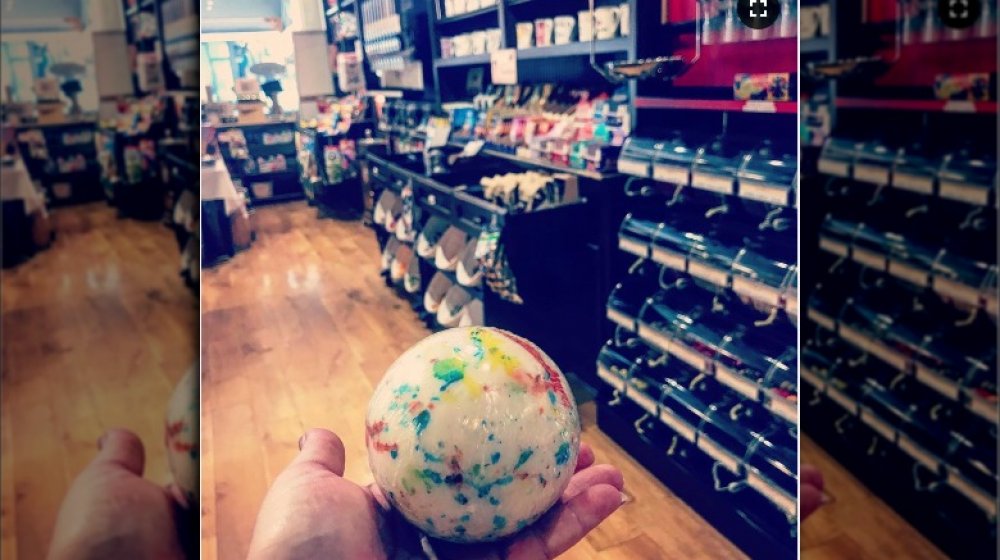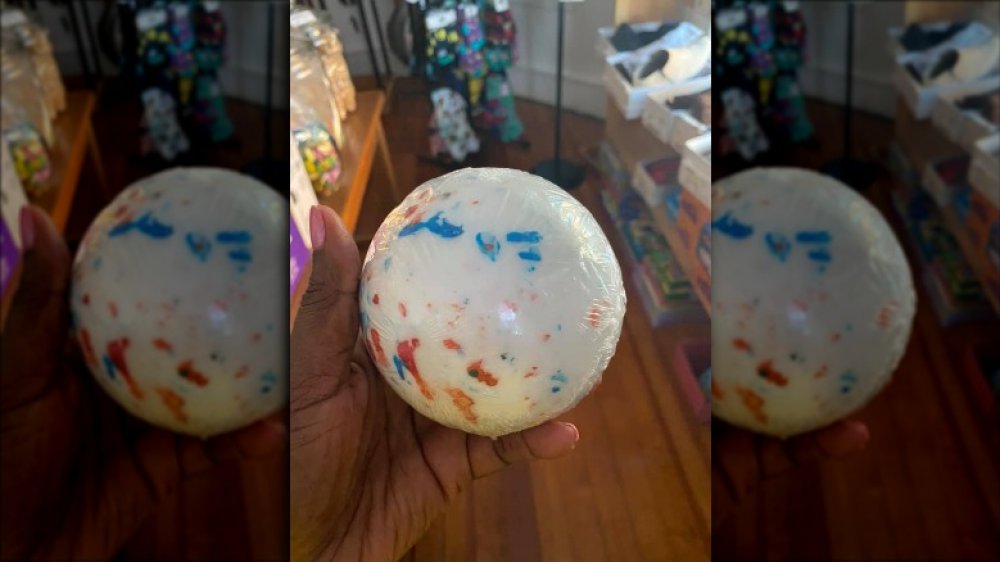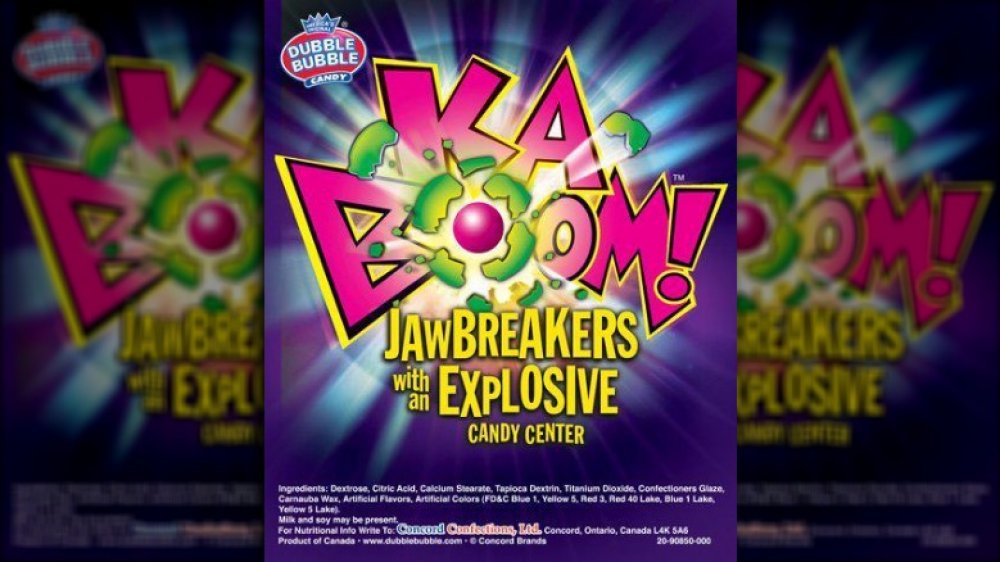This Is How Jawbreakers Are Really Made
The jawbreaker is a show-stealer in the world of candy. From its kinda scary sounding name to its trademark white candy coat and festive rainbow paint splatters, you can't miss these spherical sweets anytime you walk into a candy store. You get the feeling they've been around forever, and yet, it's hard to pin down exactly when jawbreakers made their entrance onto the sweets scene.
Some believe that jawbreakers are descendants of the sugar plum, which is a hard-coated candy that has been around since the 1600s. What we do know is that Salvatore Ferrara, an Italian baker that immigrated to Illinois, Chicago, in 1919, is the one who popularized jawbreakers in the States. Since then, the Ferrara Pan Candy Company has grown and merged to become the big candy company we know today: the Ferrara Candy Company.
You may know jawbreakers by another name: gobstoppers. That's the term used in the UK for these hard-shelled sweets. Relatedly, the name "Everlasting Gobstoppers" comes from British author Roald Dahl's 1964 novel Charlie and the Chocolate Factory, where he envisions a gobstopper that never grows smaller and lasts forever, changing colors and flavor like magic. Even if they're not really everlasting, jawbreakers do last a long time and change colors and flavors in real life thanks to a high-tech process that can take close to a month to complete. Here at Mashed, we've got all the sweet details for you to munch on.
Jawbreakers start with the hard candy center
Though these candies seem to last forever (hence the description "everlasting"), you probably remember getting to the sweet, sour center of a jawbreaker and feeling that sense of accomplishment of a job well done.
For classic jawbreakers, that hard candy center is where candymakers start their work. Weighted tumble blocks are placed into an industrial-sized panner. The tumble blocks are necessary for crushing and mixing the candy center ingredients together into a fine powder.
Dextrose, powdered coloring, flavoring, and fruit acids are added to the panner along with the blocks. After the tumble blocks and panner work their magic for about ten minutes, the powdery mixture gets transferred to a custom pill-press device. There, a high-powered piston molds it into the round tangy candy center we all know and love. Can you believe how much work goes into just a small part of our beloved jawbreakers? That's just the beginning.
Bubblegum centers are also popular in jawbreakers
Before we get to the color-changing layers, we can't forget the lengthy process that goes into making another popular kind of jawbreaker: the ones with chewy, gooey bubble-gum centers. Bubble gum centers require a different process in the beginning, though the layering process is the same as with hard-centered jawbreakers.
Candymakers blend synthetic rubbers with powdered resin to dissolve the rubber. Then, thickeners and preservatives are added. After a four-hour steaming and mixing process, the mixture is placed into trays for cooling. The batter cools for 24 hours, and then corn syrup is added for softness and sweetness.
Finally, sugars and flavors are added to the gum as well as icing sugar, which makes the gum easier to chew. Several machines are used to slice and shape the gum into ball centers for jawbreakers. Once these gumballs are cool, they're ready for building on layers to create a jawbreaker.
Layers upon layers are added to jawbreakers
What about all those layers and layers of flavor and color that make your tongue change color? That's the best part, in our opinion. Being rude and sticking your tongue out at people is so much more fun when the insides of your mouth are a lurid shade of blue.
Those layers are actually the most time-consuming part of the jawbreaker-making process. Once the hard candy centers are finished, they're taken to a very loud "engrossing" room, where multiple layers of flavoring and colors are added to the candy. The candies are spun in rotating panners (that's the loud part) while the syrup is added. Next, more dextrose powder is added to help build up layers.
Then come multiple stages of flavored coloring, like cherry, lime, lemon, and blueberry. Each layer makes up one of those colors that make your tongue look like you're from another planet. Each layer must have two hours to set before another layer can be added, so you can imagine how long it takes to make these color-morphing candies. The coating increases the size of the candies into the big jawbreakers we're used to seeing and chomping on.
It can actually take more than three weeks to make a jawbreaker
We call them Everlasting Gobstoppers across the pond, but they're not just everlasting to eat. The process can seem everlasting when it comes to making these colorful sweets too. While some jawbreaker candies take a few days to make, other versions can take more than three weeks to complete!
Take, for example, the Jaw Busters brand of jawbreakers. The company starts with a tiny, single granule of sugar and adds liquid sugar to build it up to half the size of a Jaw Buster. Just creating this sugary center takes about 21 days. The company then follows up with colors and flavoring in a traditional jawbreaker layering process.
If you've had Jaw Busters before, you'd know these aren't even the biggest jawbreakers around. Can you imagine how long it would take to make those HUGE jawbreakers you see in candy stores?
Finishing touches for that classic jawbreaker look
We know it's a classic jawbreaker the second we see that classic white coating and rainbow paint splatter. Some think that the origin of the white coating came from Ferrara's original product, an Italian treat called Confetti or Jordan Almonds. It's a sugar-coated almond candy, traditionally with a white candy shell. Confetti Almonds also come in a colorful candy coat, which may have inspired the confetti-like paint splatters we see on jawbreakers today. Confetti Almonds are also made with a panning process, which might have led Ferrara toward developing a method for making jawbreakers.
Today, that method is done on a large scale in industrial-sized panners. Once all flavored coloring has been added to the candies, two more layers of white coating are added to the candy. A glaze is poured onto the candies to seal in all the layers. Finally, candy makers use spray bottles of coloring on the candy while the panning machine rotates to ensure an overall paint splatter effect.
How were jawbreakers made early on?
Obviously, we've made leaps and bounds when it comes to candy-making technology, especially with the help of industrial-strength machinery and AI functionalities to ensure controlled processes. While we don't know for sure when jawbreakers were invented, we do know the older methods of making similar coated candies was much more labor-intensive.
Early coating pans were just kettles suspended on a chain that a person had to manually swing over an open fire. Candy making advanced somewhat in the early 1800s when pans fitted with shafts were invented. However, these pans still had to be manually turned during the coating process.
In 1860, the Industrial Era enabled the manufacturing of industrial pans and introduced panning techniques that candy makers still use today for coated candy. Today, we have updated versions of industrial pans that are automated and capable of making large batches of jawbreakers at a time.
Is there a way to make jawbreakers at home?
Is there a way to make jawbreakers in your own kitchen? You may not have industrial panners and pill presses at home, so mass-producing these candies at home might not be feasible. Sorry, Ferrara wannabes. But it is possible to make just one giant colorful jawbreaker at home for the heck of it.
Sure, if you've got tons of sugar, patience, and a lot of time on your hands. You'll start with six cups of sugar, which is only half of how much you'll need to complete the job. You'll melt it in water and corn syrup and add food coloring. Once your candy thermometer gets to 300 degrees Fahrenheit, you'll pour the very hot mixture into a round hemisphere pan. Then repeat to make the other half.
It takes several hours for these candies to cool and harden. Once that's done, you add some more liquid candy to stick the two halves together. Lay out some newspaper and use a toothbrush or paintbrush dipped in food coloring to get that class paint splatter effect. Now you're out of sugar, but you have a giant candy to impress your friends with!
Variations in jawbreakers
Bruisers look just like classic jawbreakers, with white coating and paint splatter designs, except they're humongous. Bigger than your average golf ball, they measure up to over three inches in diameter! These overgrown sweets are impossible to wrap your jaw around, so your best bet is to lick or bite gently at them until they diminish in size.
Before you start eating a Bruiser though, make sure you've set aside plenty of time and energy. The standing official world record for the time it takes to eat a Mega Bruiser Jawbreaker is 17 days, four hours, eight minutes, and 19 seconds! You might want to have a plastic sandwich bag handy to keep your jawbreaker in so you can save your work.
Another variation of the jawbreaker is the popular Atomic Fireball. Ferrara describes these as a "spicy hot ball of sweet burning cinnamony deliciousness." These fiery candies are a bright red color to match the spicy taste. Since candies like these are meant to last a long time, we recommend that only spicy food lovers try these flaming fireballs of sweetness.
Exploding jawbreakers?
Jawbreakers have been around so long that myths and stories about them abound. You may have heard the same urban legend we came across, which is that some jawbreakers have exploded and injured people before. Unfortunately, this is one urban legend that turned out to be true, as shown by an episode of Discovery's Myth Busters show.
Police records confirm that a jawbreaker exploded when a young child took just one lick at the candy after microwaving it. Another nine-year-old's jawbreaker exploded when she licked the candy, which left severe, painful burns on her face and arms. These were found later on to be chemical burns.
The hosts of Myth Busters decided to look into what conditions caused these jawbreaker explosions. They confirmed that the combined effect of the candy left in its plastic packaging and left out in the sun or under any other radiant heat source (they used a conventional toaster oven) resulted in a hard shell with molten candy insides. We aren't sure why licking the candy caused the explosion for these kids, but we're definitely going to avoid microwaving or leaving these candies out in the sun.
Jawbreakers on film
Like everyone else, we love anything related to the '90s: the fashion, the music, the movies! Clueless is a popular throwback, but have you heard of its darker, campier cousin, Jawbreaker? Starring '90s goth queen Rose McGowan, this black comedy is often compared to other famous movies, such as Heathers and Mean Girls.
In the movie, a group of well-dressed, popular girls always celebrate each other's birthdays with a frightening prank. The prank takes a fatal turn on their ringleader's birthday when they gag her with a giant jawbreaker that ends up choking her to death. The rest of the movie involves the gang trying to cover up their accident in a web of blackmail, deceit, and of course, head-to-toe makeovers.
Though this movie wasn't loved by critics when it came out, it has since become a cult classic and an important remnant of '90s-era retro aesthetics. The literally killer story remains a source of inspiration for costume designers and moviemakers alike. In fact, the slowed-down hallway walk from Mean Girls bears a striking resemblance to the scene in Jawbreaker. And, of course, this story gives the jawbreaker even more notorious cult status as an edgy and decorative candy for the ages.
